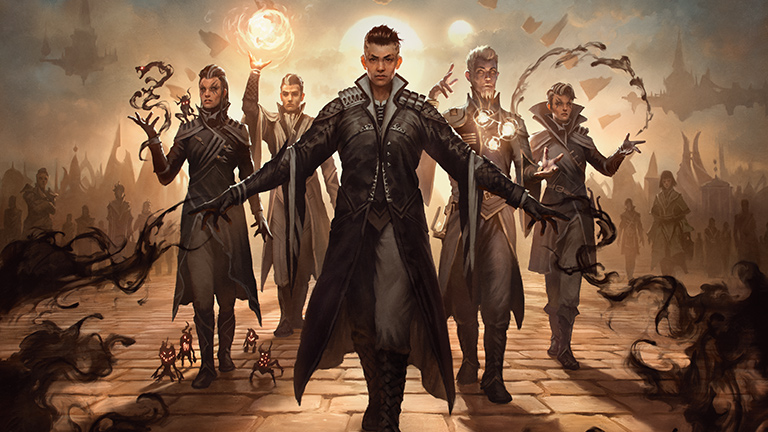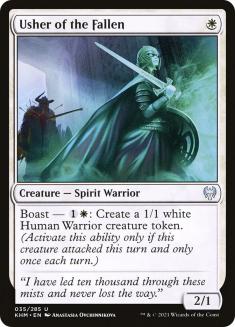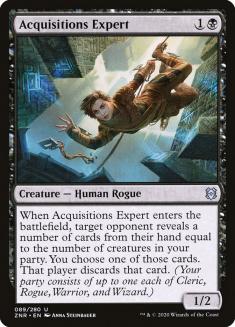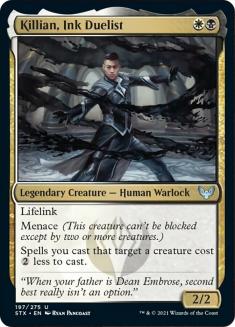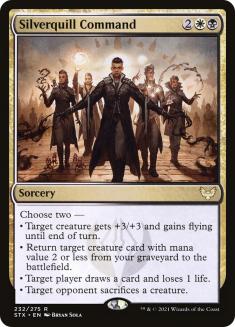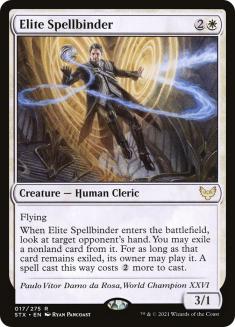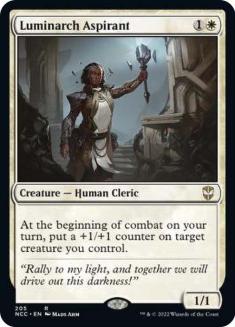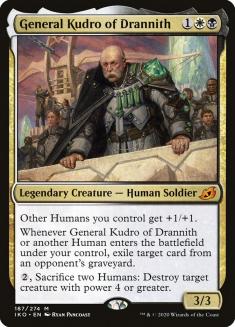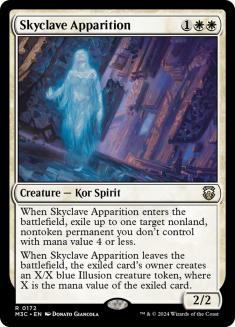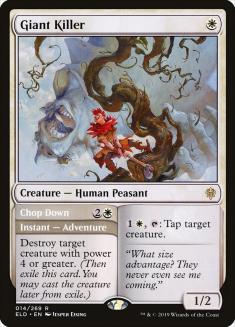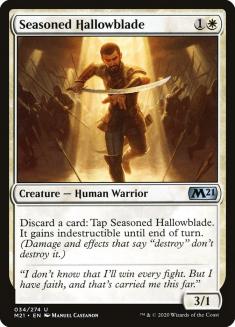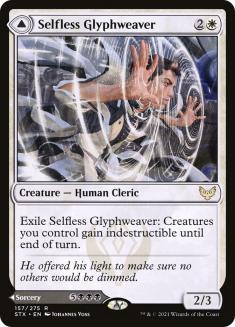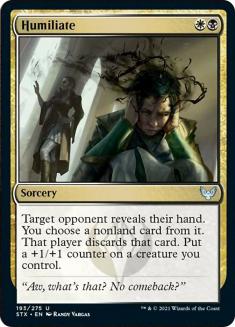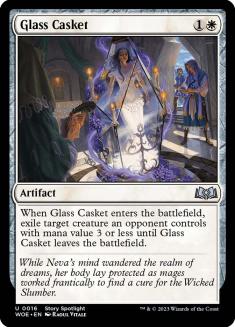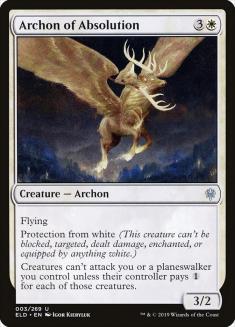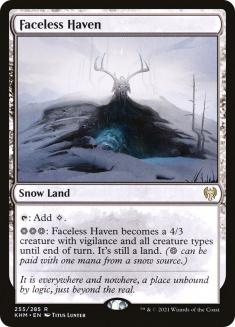Strixhaven is here and it’s time to start brewing decks! Standard is ripe for a change and I think I have just the ticket. After watching VS Live! a few days ago, there was a discussion about a potential build for a Silverquill Humans deck. There aren’t a lot of direct Human-related synergies, but playing both black and white had me curious. With so many cool Silverquill cards entering the format, it’s only right that we take a few for a spin, and what better time than opening weekend for the release of Strixhaven!
Today’s article will examine my initial build of Silverquill Humans, and my thoughts on the cards I’ve chosen to play. Let’s begin.
Creatures (34)
- 4 Giant Killer
- 3 General Kudro of Drannith
- 4 Seasoned Hallowblade
- 3 Acquisitions Expert
- 4 Skyclave Apparition
- 2 Archpriest of Iona
- 4 Luminarch Aspirant
- 4 Usher of the Fallen
- 4 Elite Spellbinder
- 2 Killian, Ink Duelist
Lands (12)
Spells (14)
Sideboard

The Bad News
Let’s get the bad news out of the way first. The mana in Strixhaven Standard for enemy-colored decks isn’t exactly ideal, but the new Snarl lands help a bit. Temple of Silence is not the card I want to play in an aggressive deck. In the past, we’ve had cycles like Brightclimb Pathway that enter the battlefield untapped. Those lands appeal to aggressive strategies because their cards are much better in the early turns.
Any time you stumble by having a land enter the battlefield tapped on a specific turn instead of casting a relevant spell, that moment will shatter any illusions that splashing a second color is “free.” It can be devastating. It will break you at times and make you wish you were playing Faceless Haven and a bunch of Snow-Covered Plains. My job is to convince you that splashing that second color is worth it.
Aggressive decks like this one tend to lose some steam as the game goes long. When entering a tournament with such a deck, it’s important to nail down some cards that give you some juice in the later turns. In this vein, we can also look for cards that allow us to use our mana to generate pressure without committing too many resources to the battlefield.
A significant threat in our build, Usher of the Fallen presents big-time pressure for a small-time investment. You choose — one mana for two power, or three mana for three power. The versatile nature shines against opponents who can’t block in the early turns, and gives you a buffer against anyone who might hurl a sweeper your way. While not a Human itself, the power-to-mana ratio is too good when you bundle in the fact that it creates Human tokens.
As we increase our reliance on black cards, the number of black sources we need to play to consistently cast our spells on time increases. Playing lands like Temple of Silence also necessitate the implementation of higher-power two-drop spells. If you skip your first-turn creature, chances are you need a bigger play on Turn 2 or Turn 3 if you want to keep pace. Luckily I’ve got an old favorite that could use a new home. While it might not be so impressive on Turn 2, it starts to gain a lot of stock as you add more creatures to the battlefield.
I haven’t seen many people talk about Acquisitions Expert in Standard since it was printed, but the freeroll nature seems to be something worth exploring. Your opponent discards a card of their choice as the default, making it Ravenous Rats-esque. Not exactly busted, but it starts to get a little more dicey as the turns go. Stealing your opponent’s one sweeper or one payoff is a great way to clinch close games. When you combine Acquisitions Expert with other tools to create disruption suites, you start to design little boxes to enclose your opponents. If you’ve ever played with Tidehollow Sculler before, you’ll know what I’m talking about.
The Good News
The new cards are great. They all have a ton of text and seem like they need a lot of work to function, but in reality they just have free abilities that you can choose to exploit or ignore given the current situation. My favorite creature of the new bunch is a member of Silverquill and has a lot of free abilities for two mana. Let’s take a gander.
Not exactly the most subtle creature, Killian, Ink Duelist seems to do it all. It’s a substantial attacker in our strategy, offering a few points of lifelink with evasion. Those two abilities alone might be good enough, but the final act is the curtain call.
This is the reason to play Silverquill. Mono-White Aggro❄ is already a pretty damn good deck in Standard, offering a lot of potential wins for a very small investment. Adding another color needs to have purpose, reason, or something truly special. I’m saying Silverquill Command falls firmly in the Truly Special™ category. Every single mode is a banger, giving the caster two relevant effects in virtually every conceivable battlefield. If Killian offers you the ability to cast that spell early while saving two mana, I can only assume that the two should go hand in hand. Exploring more build variety involving removal or enchantments could be an incredible way to take Killian if that’s your goal, but we’re kind of just leaning softly on that aspect for now.
As for Silverquill Command itself, what’s not to love? If you’re ahead, you can close the door by choosing any number of modes. I believe the most common will be “Target player draws a card and loses 1 life.” and “Target opponent sacrifices a creature.”, clearing the path for your little troop and providing some more on the back end. However, the fact that two other modes exist means you get twice as many choices and all of them are good. If Elspeth, Knight-Errant taught me anything, it’s that an Angelic Blessing isn’t so bad when it’s optional. Choosing that mode probably won’t happen often, but the times it does will almost certainly win the game via killing a planeswalker or closing out the last few points of damage.
Against a controlling opponent with a lot of cheap interaction, the “Return target creature card with mana value 2 or less from your graveyard to the battlefield.” + “Target player draws a card and loses 1 life.” sequence leaves you up on cards and gives you a threat. If they have a creature on the battlefield, the “Return target creature card with mana value 2 or less from your graveyard to the battlefield.” + “Target opponent sacrifices a creature.” option is absolutely brutal.
Of all the commands, Silverquill Command strikes me as the most impactful for the price. All of them look solid on paper, and I’m looking forward to trying them in a host of archetypes, but I can’t see myself wanting to do anything other than cast Silverquill Command for a long time to come. It reminds me of Kolaghan’s Command and Ojutai’s Command strapped together. It’s a recursion nightmare for the opponent or just a really good spell when you’re at parity. If all I’m doing is trying to find a deck that plays Silverquill Command, I’ll be a happy camper.
A new contender, Elite Spellbinder just looks like an excellent tool for aggressive decks on paper. There’s perhaps a good chance it ends up being a bit weaker in Standard than formats featuring Flickerwisp, but I want to give it a fair shake before moving to a more aggressive build. The evasion is excellent, and stalling out your opponent’s best card all while having three power for three mana is such a boon for white.
There have been a lot of conversations about where to take white as a color in theory. For years, it’s felt like white was just “White Weenie” and “Support.” The only time white was actually a competitive color was when you had access to some busted five- or six-mana spell. That one spell combined with a four- or five-mana sweeper was usually enough to make white a base color, but it never really felt like home. Elite Spellbinder is one of the coolest designs for white that I’ve ever seen, and I’m confident it will see play in some older formats for a very long time. Just the thought of Elite Spellbinder with Ephemerate gives me chills.
Elite Spellbinder is a part of the crew that helps your mostly ordinary aggro deck disrupt the opponent in a unique way. Alongside Acquisitions Expert and some sideboard cards, you can squeeze your opponent into some harsh conditions that might not be possible to escape from.
The Ugly Ones We Know and Love
If you’ve played with Mono-White Aggro❄ in the last few months, you might have noticed that Luminarch Aspirant is largely responsible for a lot of the games you win. It creates landslide scenarios where opponents relying on combat to interact are largely overwhelmed for virtually no cost. On its face, without help, it’s a 2/2 on the turn you cast it that grows every turn. Placing a counter on a creature of your choice every turn provides you with sequences that obliterate your opponent’s chances of coming out of combat ahead.
The pressure generated by Luminarch Aspirant for how little mana you have to invest is baffling.
I wasn’t a fan of General Kudro of Drannith when it was first printed, but I’ve seen it do some cool things. I think it’s mostly a coincidence that many of of the best creatures in these colors are Humans because there aren’t a lot of actual Human synergies. Again, we’re relying on the sheer word count on our cards to get the job done, using about half the relevant parts at any given time. General Kudro of Drannith just so happens to pump most of those creatures, making it a solid three-drop with a bit of extra text if you need to exile an opposing creature in a pinch.
I know this is a Humans deck but it’s also a Silverquill Good Stuff deck. Skyclave Apparition might be the best white card printed in the last decade (assuming Elite Spellbinder doesn’t overtake that role in the coming months). If you play white in any format, you probably need to be looking at how to incorporate Skyclave Apparition into your strategy.
A one-drop to pair with Luminarch Aspirant to give you early damage, Giant Killer is the most fluid way I’ve ever seen to incorporate removal into an archetype that shouldn’t play too much. Chop Down is also pretty incredible when it costs two less via Killian! I don’t think I need to explain this card too much, as it’s seen play in almost every build of aggressive white decks in Standard over the last year.
I haven’t been able to kill one yet so I imagine it’s pretty good in this deck, just like it’s pretty good in every other Standard build I’ve seen. It hits hard and gets to trade cards in hand for battlefield presence. The last creature I remember playing against that made me feel like Seasoned Hallowblade makes me feel is Adanto Vanguard, and that should be saying a lot. It’s excellent in a lot of spots, and especially so when the format doesn’t call for a lot of specific removal that can contain it for cheap.
Sideboard Tips and Tricks
In the first few days of the format, understanding our sideboard cards and where they can shine will be important. Here are the cards I’ve chosen and why:
A newer addition to the format, Selfless Glyphweaver can give us protection from a big sweeper effect that doesn’t exile. I doubt we’ll be casting the backside too often, but I could see it being a nice reset button off the top when you’re in need of an actual factual miracle. If your opponent has sweepers in their deck that Selfless Glyphweaver can stop, bring it in.
Humiliate and Selfless Glyphweaver will both be solid against control decks in conjunction with the disruptive package of Acquisitions Expert and Elite Spellbinder. In those matchups, it’s likely that Skyclave Apparition should be exiting the deck, as the number of targets will be zero to few. The discard effect here is powerful, but just seems disgusting when combined with any one-drop creature. That little boost might seem small, but it’s outrageous in some spots.
Nothing fancy, but we need a few more interactive game pieces against the aggro decks. Glass Casket has been the go-to for a while now and for good reason. It’s cheap and effective at slowing down other aggro decks. Clearing out big beaters like Lovestruck Beast is imperative for maintaining damage flow. If you don’t get something like that out of the way, we’re a lot more reliant on evasion.
What a hoser card. Archon of Absolution is one of the more disgusting cards for the mirror or similar decks. It’s a little expensive, but well worth the wait. Protection from white is some Old Testament Magic, and I’m gonna lean hard into it when they make a card that just humiliates the mirror.
Faceless Haven Blues
Faceless Haven is excellent. There’s no way around it. Almost every monocolored aggro deck should be playing snow lands and this new version of Mutavault. Two-color decks need to seriously consider what exactly they’re playing a second color for, because it might just be worse than playing Faceless Haven.
As we play more with the multicolor cards from Strixhaven, we may discover three-color decks that can harmonize between multiple factions. I’d love to see Silverquill Command in a Mardu Sacrifice deck as a way to return early-drops that were used as fodder. For now, I want to see just how good it could be in an aggro strategy so that Angelic Blessing choice could have some relevance.
It’s a bit weird to me that we’ve basically started to boil the format down to Faceless Haven or three-color sludge, but lands as powerful as Faceless Haven tend to homogenize the format a bit. Mutavault did this a staggering amount in Pioneer, offering a cheap and easy way to use all your mana every turn. When you’re playing a powerful format, finding ways to use all your mana is revolutionary.
As we get into some tournaments this weekend featuring Strixhaven, it’ll be interesting to see all the new brews. I’m excited to try these new cards out in a bunch of different formats. My article from last week even included a Vintage list because I liked Expressive Iteration so much!
Is Silverquill Command as good as I think it is? We’ll get to see soon enough.

